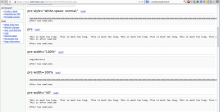Author: ui2t5v002
Description:
The fact that a pre section overflows its little blue dotted box is a bug. It
happens in Firefox, but not in IE.
Wanting it to have auto overflow is a feature request but also the only solution
I know of. Adding
pre { overflow: auto; }
to the css file fixes it under firefox, but not IE. adding width information to
the pre section in conjuction with the above does mostly fix it in IE, though it
adds a vertical scrollbar too, for some reason.
This page:
http://www.magpiebrain.com/archives/2004/04/19/ie_and_overflow_auto
explains how to make it even better in IE.
See Also:


